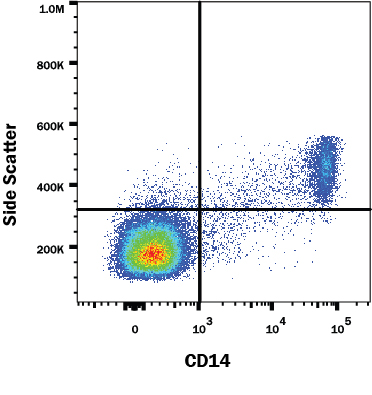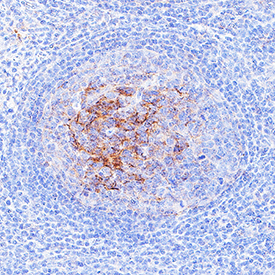Human CD14 Antibody Summary
Thr20-Cys352
Accession # P08571
Applications
Please Note: Optimal dilutions should be determined by each laboratory for each application. General Protocols are available in the Technical Information section on our website.
Scientific Data
 View Larger
View Larger
Detection of Human CD14 by Western Blot. Western blot shows lysates of human peripheral blood mononuclear cells (PBMC). PVDF membrane was probed with 2 µg/mL of Mouse Anti-Human CD14 Monoclonal Antibody (Catalog # MAB3832) followed by HRP-conjugated Anti-Mouse IgG Secondary Antibody (HAF018). A specific band was detected for CD14 at approximately 55 kDa (as indicated). This experiment was conducted under non-reducing conditions and using Western Blot Buffer Group 1.
 View Larger
View Larger
Detection of CD14 in Human PBMCs by Flow Cytometry. Human peripheral blood mononuclear cells (PBMCs) were stained with Mouse Anti-Human CD14 Monoclonal Antibody (Catalog # MAB3832) followed by Goat anti-Mouse IgG APC-conjugated Secondary Antibody (Catalog # F0101B). View our protocol for Staining Membrane-associated Proteins.
 View Larger
View Larger
Detection of CD14 in human tonsil. CD14 was detected in immersion fixed paraffin-embedded sections of human tonsil using Mouse Anti-Human CD14 Monoclonal Antibody (Catalog # MAB3832) at 5 µg/mL for 1 hour at room temperature followed by incubation with the Anti-Mouse IgG VisUCyte™ HRP Polymer Antibody (Catalog # VC001). Before incubation with the primary antibody, tissue was subjected to heat-induced epitope retrieval using VisUCyte Antigen Retrieval Reagent-Basic (Catalog # VCTS021). Tissue was stained using DAB (brown) and counterstained with hematoxylin (blue). Specific staining was localized to cell surface in lymphocytes. View our protocol for IHC Staining with VisUCyte HRP Polymer Detection Reagents.
Reconstitution Calculator
Preparation and Storage
- 12 months from date of receipt, -20 to -70 °C as supplied.
- 1 month, 2 to 8 °C under sterile conditions after reconstitution.
- 6 months, -20 to -70 °C under sterile conditions after reconstitution.
Background: CD14
CD14 is a 55 kDa cell surface glycoprotein that is preferentially expressed on monocytes/macrophages. The human CD14 cDNA encodes a 375 amino acid (aa) residue precursor protein with a 19 aa signal peptide and a C-terminal hydrophobic region characteristic for glycosylphosphatidyinositol (GPI)-anchored proteins. Human CD14 has four potential N-linked glycosylation sites and also bears O-linked carbohydrates. The amino acid sequence of human CD14 is approximately 65% identical with the mouse, rat, rabbit, and bovine proteins. CD14 is a pattern recognition receptor that binds lipopolysaccharides (LPS) and a variety of ligands derived from different microbial sources. The binding of CD14 with LPS is catalyzed by LPS-binding protein (LBP). The toll-like-receptors have also been implicated in the transduction of CD14-LPS signals. Similar to other GPI-anchored proteins, soluble CD14 can be released from the cell surface by phosphatidyinositol-specific phospholipase C. Soluble CD14 has been detected in serum and body fluids. High concentrations of soluble CD14 have been shown to inhibit LPS-mediated responses. However, soluble CD14 can also potentiate LPS response in cells that do not express cell surface CD14.
- Wright, S.D. et al. (1990) Science 249:1431.
- Pugin, J. et al. (1993) Proc. Natl. Acad. Sci. USA 90:2744.
- Beutler, B. (2000) Current Opinion in Immunology 12:20.
- Stelter, F. (2000) Chem. Immunol. 74:25.
Product Datasheets
Citations for Human CD14 Antibody
R&D Systems personnel manually curate a database that contains references using R&D Systems products. The data collected includes not only links to publications in PubMed, but also provides information about sample types, species, and experimental conditions.
16
Citations: Showing 1 - 10
Filter your results:
Filter by:
-
DEC205 mediates local and systemic immune responses to Helicobacter pylori infection in humans
Authors: M Kita, K Yokota, C Kageyama, S Take, K Goto, Y Kawahara, O Matsushita, H Okada
Oncotarget, 2018-02-26;9(22):15828-15835.
Species: Human
Sample Types: Whole Cells
Applications: Neutralization -
Engineering the geometrical shape of mesenchymal stromal cells through defined cyclic stretch regimens
Authors: B Walters, T Uynuk-Ool, M Rothdiener, J Palm, ML Hart, JP Stegemann, B Rolauffs
Sci Rep, 2017-07-26;7(1):6640.
Species: Human
Sample Types: Whole Cells
Applications: Flow Cytometry -
Detection of tissue factor-positive extracellular vesicles by laser scanning confocal microscopy
Authors: Yohei Hisada
Thromb. Res, 2016-12-23;150(0):65-72.
Species: Human
Sample Types: Whole Cells
Applications: ICC -
Granzymes A and K differentially potentiate LPS-induced cytokine response
Authors: Annette C Wensink
Cell Death Discov, 2016-12-12;2(0):16084.
Species: Human
Sample Types: Whole Cells
Applications: Neutralization -
Synergic effects of VEGF-A and SDF-1 on the angiogenic properties of endothelial progenitor cells
Authors: Gabriela Odent Grig
J Tissue Eng Regen Med, 2016-12-12;0(0):.
Species: Human
Sample Types: Whole Cells
Applications: Flow Cytometry -
Extracellular Vesicle Proteins Associated with Systemic Vascular Events Correlate with Heart Failure: An Observational Study in a Dyspnoea Cohort.
Authors: Zhang Y, Vernooij F, Ibrahim I, Ooi S, Gijsberts C, Schoneveld A, Sen K, den Ruijter H, Timmers L, Richards A, Jong C, Mazlan I, Wang J, Lam C, de Kleijn D
PLoS ONE, 2016-01-28;11(1):e0148073.
Species: Human
Sample Types: Plasma
Applications: ELISA Development -
Secreted Thrombospondin-1 Regulates Macrophage Interleukin-1beta Production and Activation through CD47.
Authors: Stein E, Miller T, Ivins-O'Keefe K, Kaur S, Roberts D
Sci Rep, 2016-01-27;6(0):19684.
Species: Human
Sample Types: Cell Lysates
Applications: Western Blot -
Sialylation of Campylobacter jejuni endotoxin promotes dendritic cell-mediated B cell responses through CD14-dependent production of IFN-beta and TNF-alpha.
Authors: Huizinga R, van Rijs W, Bajramovic J, Kuijf M, Laman J, Samsom J, Jacobs B
J Immunol, 2013-10-28;191(11):5636-45.
Species: Human
Sample Types: Whole Cells
Applications: Neutralization -
Mycobacterium tuberculosis infection and tissue factor expression in macrophages.
Authors: Kothari H, Rao L, Vankayalapati R, Pendurthi U
PLoS ONE, 2012-09-24;7(9):e45700.
Species: Human
Sample Types: Whole Cells
Applications: Neutralization -
Bovine lactoferrin counteracts Toll-like receptor mediated activation signals in antigen presenting cells.
Authors: Puddu P, Latorre D, Carollo M, Catizone A, Ricci G, Valenti P, Gessani S
PLoS ONE, 2011-07-25;6(7):e22504.
Species: Human
Sample Types: Whole Cells
Applications: Flow Cytometry -
Human mesenchymal stromal cells express CD14 cross-reactive epitopes.
Authors: Pilz GA, Braun J, Ulrich C, Felka T, Warstat K, Ruh M, Schewe B, Abele H, Larbi A, Aicher WK
Cytometry A, 2011-07-06;79(8):635-45.
Species: Human
Sample Types: Cell Lysates
Applications: Western Blot -
Iris pigment epithelial cells express a functional lipopolysaccharide receptor complex.
Authors: Chui JJ, Li MW, Di Girolamo N, Chang JH, McCluskey PJ, Wakefield D
Invest. Ophthalmol. Vis. Sci., 2009-12-17;51(5):2558-67.
Species: Human
Sample Types: Cell Lysates, Whole Cells
Applications: Neutralization, Western Blot -
Functional dissection of an IFN-alpha/beta receptor 1 promoter variant that confers higher risk to chronic hepatitis B virus infection.
Authors: Zhou J, Huang JD, Poon VK, Chen DQ, Chan CC, Ng F, Guan XY, Watt RM, Lu L, Yuen KY, Zheng BJ
J. Hepatol., 2009-05-03;51(2):322-32.
Species: Human
Sample Types: Whole Cells
Applications: Flow Cytometry -
IL-1alpha and IL-1beta are endogenous mediators linking cell injury to the adaptive alloimmune response.
Authors: Rao DA, Tracey KJ, Pober JS
J. Immunol., 2007-11-15;179(10):6536-46.
Species: Human
Sample Types: Whole Cells
Applications: Neutralization -
Borrelia burgdorferi-induced monocyte chemoattractant protein-1 production in vivo and in vitro.
Authors: Zhao Z, McCloud B, Fleming R, Klempner MS
Biochem. Biophys. Res. Commun., 2007-05-02;358(2):528-33.
Species: Human
Sample Types: Whole Cells
Applications: Neutralization -
LPS/CD14 activation triggers SGLT-1-mediated glucose uptake and cell rescue in intestinal epithelial cells via early apoptotic signals upstream of caspase-3.
Authors: Yu LC, Turner JR, Buret AG
Exp. Cell Res., 2006-06-22;312(17):3276-86.
Species: Human
Sample Types: Whole Cells
Applications: ICC, Neutralization
FAQs
No product specific FAQs exist for this product, however you may
View all Antibody FAQsReviews for Human CD14 Antibody
Average Rating: 4.5 (Based on 2 Reviews)
Have you used Human CD14 Antibody?
Submit a review and receive an Amazon gift card.
$25/€18/£15/$25CAN/¥75 Yuan/¥2500 Yen for a review with an image
$10/€7/£6/$10 CAD/¥70 Yuan/¥1110 Yen for a review without an image
Filter by:
Cells lysed in NP-40 lysis buffer. TBST-150mM NaCl. Blocked with 5% milk TBST. Antibody diluted in 2% milk TBST 1:100 (5ug/ml). Product works better under non-reducing conditions.








